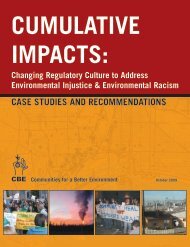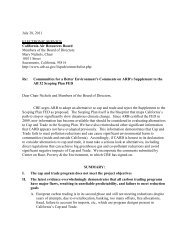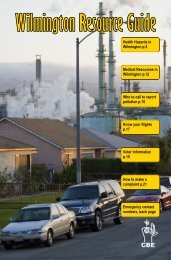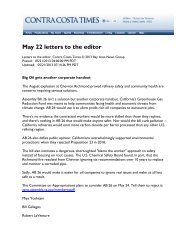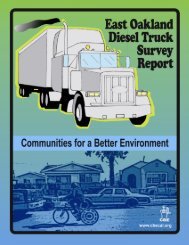The Increasing Burden of Oil Refineries and Fossil Fuels in ...
The Increasing Burden of Oil Refineries and Fossil Fuels in ...
The Increasing Burden of Oil Refineries and Fossil Fuels in ...
You also want an ePaper? Increase the reach of your titles
YUMPU automatically turns print PDFs into web optimized ePapers that Google loves.
14 <strong>The</strong> <strong>Increas<strong>in</strong>g</strong> <strong>Burden</strong> <strong>of</strong> <strong>Oil</strong> <strong>Ref<strong>in</strong>eries</strong> <strong>and</strong> <strong>Fossil</strong> FuellCalifornia ref<strong>in</strong>eries: How big are they?How dirty is the crude oil to make gasol<strong>in</strong>e, diesel& jet fuel?<strong>The</strong> table below shows crude oil used by each Californiaref<strong>in</strong>ery, split <strong>in</strong>to three big regions. Crude oil is processedthrough heat<strong>in</strong>g, crack<strong>in</strong>g, <strong>and</strong> chemical reactionsto make gasol<strong>in</strong>e, diesel, jet fuel, etc. <strong>The</strong> first columnshows the maximum capacity <strong>of</strong> the ref<strong>in</strong>ery to processcrude oil (a volume <strong>in</strong> barrels per day or bpd), the nextshows the volume <strong>of</strong> crude oil imported to each ref<strong>in</strong>eryfrom outside the US, <strong>and</strong> the last shows the domestic(US) crude oil used at the ref<strong>in</strong>ery. <strong>The</strong> US Energy InformationAdm<strong>in</strong>istration (EIA) provides public data onl<strong>in</strong>eon imported crude oil, but not domestic crude. Domesticcrude <strong>in</strong>formation had to be searched through varioussources <strong>and</strong> was not always available. See notes at end <strong>of</strong>this report. <strong>The</strong> Wilm<strong>in</strong>gton/Carson area makes up almosta third <strong>of</strong> the state’s total ref<strong>in</strong><strong>in</strong>g capacity.(In order <strong>of</strong> largest to smallest<strong>in</strong> each region)MAXIMUMCRUDE OILCAPACITY 2009Barrels/day (bpd)IMPORTED CRUDE USED2006 23 Capacity (bpd)Average Sulfur %Density (API °)DOMESTIC CRUDE USED2006 estimated 24 (bpd)*Less data available — On average—about 80% sour 25LOS ANGELES REGION 1,250,500 bpd, WILMINGTON/CARSON total: 649,000 bpdBPCarsonCONOCOPHILLIPSWilm<strong>in</strong>gton & Carson(two <strong>in</strong>tegrated sites)VALEROWilm<strong>in</strong>gton(previously Ultramar)TESOROWilm<strong>in</strong>gton(previously Shell)CHEVRONEl SegundoEXXON MOBILTorrancePARAMOUNTParamountEDGINGTONLong BeachLUNDAY THAGARDSouth Gate275,000 134,000 bpd – 51%Sulfur: 1.38% SOUR29.88° Intermediate.139,000 68,452 bpd – 49.2%Sulfur: 2.89% SOUR30.44° Intermediate135,000 61,742 bpdSulfur: 1.55% SOUR22.35° Heavy100,00023,645 bpd – 24%Sulfur: 2.7% 26SOUR21.9° 27 Heavy270,000 245,097 bpd – 94.3%Sulfur: 1.61% – SOUR27.79° Intermediate149,000 053,00091,980*51,500*13,976SOURHeavy54,644San Joaqu<strong>in</strong> pipel<strong>in</strong>e & LAbas<strong>in</strong> (SEC)10,879*109,135*0 36,500*35,000 5,903 bpd - 22.7%Sulfur: 1.55% – SOUR 14,671*23.50° Heavy8,5000 6,205*



